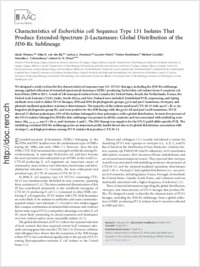Characteristics of Escherichia coli sequence type 131 isolates that produce extended-spectrum β-lactamases: global distribution of the H30-Rx sublineage
- Peirano, Gisele Division of Microbiology, Calgary Laboratory Services, University of Calgary, Calgary, Alberta, Canada - Departments of Pathology & Laboratory Medicine, University of Calgary, Calgary, Alberta, Canada
- Bij, Akke K. van der Centre for Infectious Disease Control, Epidemiology and Surveillance, Bilthoven, the Netherlands - Reinier de Graaf Hospital, Delft, the Netherlands
- Freeman, Joshua L. Auckland District Health Board, Auckland, New Zealand - University of Auckland, Auckland, New Zealand
- Poirel, Laurent Medical and Molecular Microbiology Unit, Department of Medicine, Faculty of Science, University of Fribourg, Switzerland
- Nordmann, Patrice Medical and Molecular Microbiology Unit, Department of Medicine, Faculty of Science, University of Fribourg, Switzerland
- Costello, Michael Microbiology, ACL Laboratories, Rosemont, Illinois, USA
- Tchesnokova, Veronika L. Department of Microbiology, University of Washington, Seattle, Washington, USA
- Pitout, Johann D. D. Division of Microbiology, Calgary Laboratory Services, University of Calgary, Calgary, Alberta, Canada - Departments of Pathology & Laboratory Medicine, University of Calgary, Calgary, Alberta, Canada
-
07.01.2014
Published in:
- Antimicrobial Agents and Chemotherapy. - 2014, vol. 58, no. 7, p. 3762–3767
English
We designed a study to describe the characteristics of sequence type 131 (ST131) lineages, including the H30-Rx sublineage, among a global collection of extended-spectrum β-lactamase (ESBL)-producing Escherichia coli isolates from 9 countries collected from 2000 to 2011. A total of 240 nonrepeat isolates from Canada, the United States, Brazil, the Netherlands, France, the United Arab Emirates (UAE), India, South Africa, and New Zealand were included. Established PCR, sequencing, and typing methods were used to define ST131 lineages, H30 and H30-Rx phylogenetic groups, gyrA and parC mutations, virotypes, and plasmid-mediated quinolone resistance determinants. The majority of the isolates produced CTX-M-15 with aac(6′)-lb-cr, belonged to phylogenetic group B2, and were positive for the H30 lineage with the gyrA1AB and parC1aAB mutations. ST131 showed 15 distinct pulsotypes; 43% of the isolates belonged to four pulsotypes, with a global distribution. Seventy-five percent of the ST131 isolates belonged to H30-Rx; this sublineage was present in all the countries and was associated with multidrug resistance, blaCTX-M-15, aac(6′)-lb-cr, and virotypes A and C. The H41 lineage was negative for the ST131 pabB allele-specific PCR. The multidrug-resistant H30-Rx sublineage poses an important public health threat due to its global distribution, association with virotype C, and high prevalence among ST131 isolates that produce CTX-M-15.
- Faculty
- Faculté des sciences et de médecine
- Department
- Médecine 3ème année
- Language
-
- English
- Classification
- Biological sciences
- License
-
License undefined
- Identifiers
-
- RERO DOC 213279
- DOI 10.1128/AAC.02428-14
- Persistent URL
- https://folia.unifr.ch/unifr/documents/303638
Statistics
Document views: 104
File downloads:
- pdf: 233
